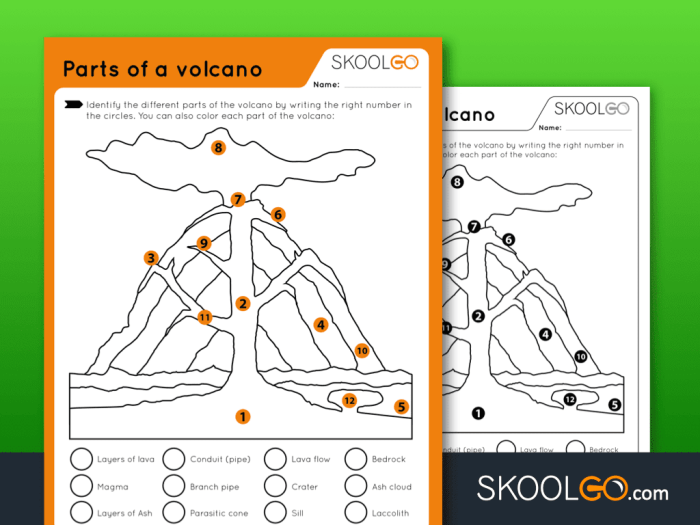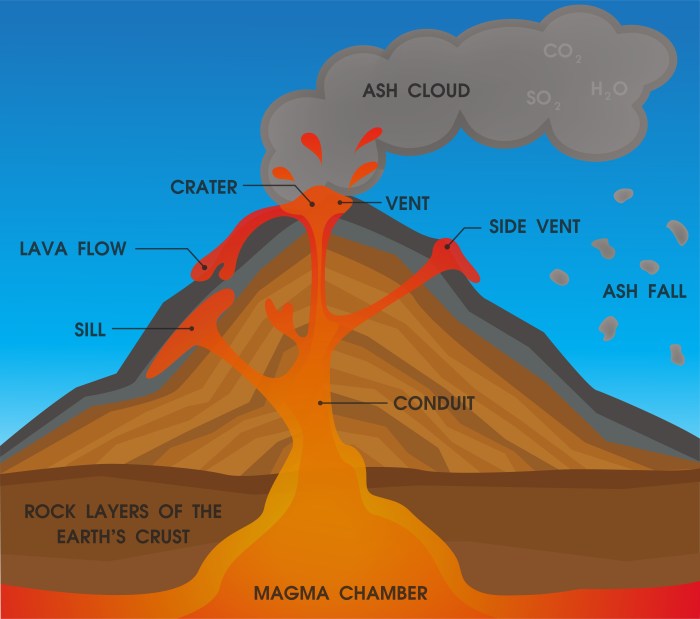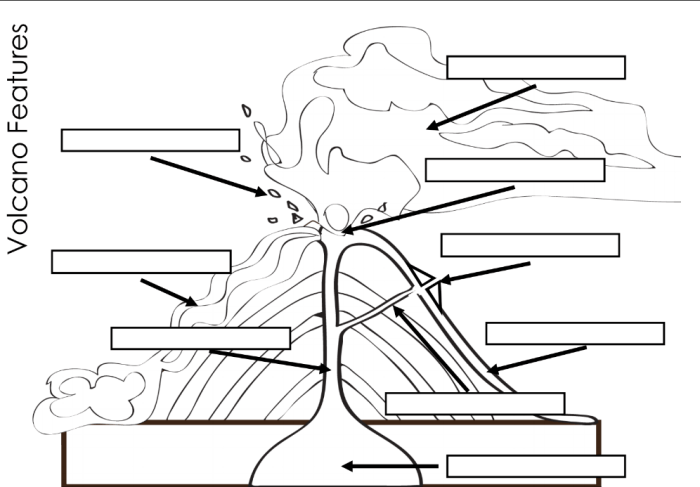Embark on a captivating journey into the fiery heart of a volcano with our parts of a volcano worksheet. Delve into the intricacies of this geological marvel, exploring its anatomy, eruptions, products, and the awe-inspiring hazards it wields.
Uncover the structure of a volcano, its external and internal components laid bare. Witness the diverse types of volcanoes, each with its unique characteristics. Dive into the volcanic eruption process, from magma formation to the explosive release of volcanic fury.
Volcano Anatomy

Volcanoes are fascinating geological formations that have captured the attention of scientists and nature enthusiasts alike. Understanding their structure is crucial for comprehending volcanic processes and assessing potential hazards.
External Parts of a Volcano
The external parts of a volcano are visible above the Earth’s surface. They include:
- Crater:A bowl-shaped depression at the volcano’s summit, formed by past eruptions.
- Cone:The conical-shaped structure surrounding the crater, built from layers of erupted material.
- Flank:The sides of the volcano, typically sloping gently away from the summit.
- Base:The point where the volcano meets the surrounding land or seafloor.
Internal Parts of a Volcano
The internal parts of a volcano are hidden beneath the Earth’s surface. They include:
- Magma Chamber:A reservoir of molten rock beneath the volcano, the source of volcanic eruptions.
- Vent:A passageway through which magma rises from the magma chamber to the surface.
- Dike:A sheet-like intrusion of magma that cuts through surrounding rock.
- Sill:A sheet-like intrusion of magma that occurs between layers of rock.
Types of Volcanoes
Volcanoes can be classified into different types based on their shape, eruptive behavior, and composition. Some common types include:
- Stratovolcano:A tall, cone-shaped volcano with alternating layers of lava and ash.
- Shield Volcano:A broad, gently sloping volcano formed by fluid lava flows.
- Cinder Cone:A small, steep-sided volcano built from loose volcanic fragments.
- Caldera:A large, collapsed volcanic crater formed by a massive eruption.
Volcanic Eruptions
Volcanic eruptions occur when molten rock (magma) rises to the surface of the Earth. The process begins deep within the Earth’s crust, where extreme heat and pressure cause rocks to melt and form magma. As the magma rises, it can accumulate in a magma chamber beneath a volcano.
If the pressure in the magma chamber becomes too great, the magma will erupt through a vent in the volcano’s surface.
Types of Volcanic Eruptions
There are several different types of volcanic eruptions, each with its own unique characteristics and hazards. Some of the most common types of eruptions include:
- Effusive eruptionsare characterized by the outpouring of large volumes of lava. These eruptions are typically less explosive than other types of eruptions and can produce lava flows that can travel for long distances.
- Explosive eruptionsare characterized by the violent ejection of ash, pumice, and other volcanic materials. These eruptions can be extremely dangerous and can cause widespread damage.
- Phreatomagmatic eruptionsoccur when magma interacts with water, either from a lake, river, or groundwater. These eruptions can produce large amounts of steam and ash, and can be extremely destructive.
Factors Influencing Volcanic Eruptions
The severity and frequency of volcanic eruptions are influenced by a number of factors, including:
- Magma composition: The composition of the magma can affect the type and severity of an eruption. Magma that is rich in silica is more viscous and tends to produce explosive eruptions, while magma that is poor in silica is less viscous and tends to produce effusive eruptions.
- Gas content: The amount of gas dissolved in the magma can also affect the type and severity of an eruption. Magma that contains a lot of gas is more likely to produce explosive eruptions, while magma that contains less gas is more likely to produce effusive eruptions.
- Volcano shape: The shape of a volcano can also affect the type and severity of an eruption. Volcanoes with steep slopes are more likely to produce explosive eruptions, while volcanoes with gentle slopes are more likely to produce effusive eruptions.
Volcanic Products

Volcanic eruptions produce a wide range of materials, collectively known as volcanic products. These products vary in composition, texture, and size, and can have a significant impact on the surrounding environment.
The primary volcanic products include lava, ash, and pyroclastic materials.
Lava
Lava is molten rock that erupts from a volcano. It is composed primarily of silicate minerals, and its composition can vary depending on the volcano’s magma source. Lava flows can range in temperature from 700 to 1200 degrees Celsius, and they can travel at speeds of up to 60 kilometers per hour.
When lava cools and solidifies, it forms volcanic rock. The type of volcanic rock that forms depends on the composition of the lava and the rate at which it cools.
Ash
Ash is composed of fine particles of volcanic rock and glass. It is produced when lava is ejected into the air and breaks into small fragments. Ash can be carried by the wind over long distances, and it can cause respiratory problems and damage crops.
Ash deposits can also form layers of rock called tuff. Tuff is a soft, porous rock that is easily eroded.
Pyroclastic Materials
Pyroclastic materials are a general term for any volcanic material that is ejected into the air during an eruption. Pyroclastic materials can include ash, lapilli, bombs, and blocks.
- Lapilli are small fragments of volcanic rock that range in size from 2 to 64 millimeters.
- Bombs are larger fragments of volcanic rock that range in size from 64 millimeters to several meters.
- Blocks are the largest fragments of volcanic rock that are ejected during an eruption. They can be several meters in size.
Pyroclastic materials can be extremely hot and dangerous. They can cause burns, crush injuries, and death.
Impact of Volcanic Products on the Environment
Volcanic products can have a significant impact on the surrounding environment. Lava flows can destroy buildings and infrastructure, and they can also block rivers and roads.
Ash can damage crops, pollute water supplies, and cause respiratory problems. Pyroclastic materials can cause burns, crush injuries, and death.
Studying parts of a volcano worksheet can be an interesting way to learn about volcanoes. If you’re looking for more information on chemical reactions, you might want to check out the hcn + koh net ionic equation . Once you’ve familiarized yourself with that, you can come back to the parts of a volcano worksheet and continue your studies.
In addition to the immediate impacts of volcanic eruptions, volcanic products can also have long-term effects on the environment. For example, volcanic ash can alter the chemistry of soils, and it can also contribute to the formation of new landforms.
Volcanic Hazards

Volcanic eruptions can pose significant threats to human populations and infrastructure. These hazards include lava flows, ash clouds, lahars, and other related phenomena. Understanding these hazards and implementing effective mitigation strategies is crucial for reducing their risks and safeguarding communities.
Lava Flows, Parts of a volcano worksheet
Lava flows are streams of molten rock that erupt from volcanoes. They can travel at high speeds, destroying everything in their path. Lava flows can cause severe burns, ignite fires, and damage or destroy buildings, roads, and other infrastructure.
Ash Clouds
Ash clouds are composed of tiny particles of rock and glass that are ejected into the atmosphere during volcanic eruptions. These clouds can spread over vast distances, disrupting air travel, blocking sunlight, and causing respiratory problems in humans and animals.
Ashfall can also damage crops, contaminate water supplies, and clog machinery.
Lahars
Lahars are destructive mudflows or debris flows that form when volcanic material mixes with water. They can travel at high speeds, carrying large boulders and debris. Lahars can cause widespread damage to infrastructure, property, and human life.
Other Volcanic Hazards
In addition to lava flows, ash clouds, and lahars, other volcanic hazards include:
Pyroclastic flows
Fast-moving clouds of hot gas and ash that can travel at speeds of up to 700 kilometers per hour.
Volcanic bombs
Large pieces of rock that are ejected from volcanoes during eruptions.
Volcanic lightning
Electrical discharges that occur within volcanic clouds.
Volcanic Monitoring and Prediction
Volcanic activity is a complex phenomenon that can pose significant threats to human populations and infrastructure. To mitigate these risks, scientists have developed various techniques to monitor and predict volcanic eruptions.
Seismic Monitoring
- Seismometers detect and record seismic waves generated by volcanic activity.
- Different types of seismic waves provide information about the location, depth, and magnitude of volcanic earthquakes.
- Seismic monitoring helps identify areas of increased activity and track the progression of magma movement.
Gas Analysis
- Volcanoes emit various gases, including sulfur dioxide, carbon dioxide, and water vapor.
- Changes in gas composition and emission rates can indicate impending eruptions.
- Gas analysis provides insights into the magma’s composition and the dynamics of the volcanic system.
Challenges and Limitations of Volcanic Prediction
While volcanic monitoring techniques have improved, predicting eruptions remains a complex and challenging task.
- Volcanic systems are highly complex and influenced by numerous factors.
- Eruptions can be triggered by a combination of factors, making it difficult to pinpoint the exact timing and magnitude.
- Predicting eruptions with sufficient lead time to evacuate populations remains a significant challenge.
Importance of Early Warning Systems and Evacuation Plans
Despite the challenges of volcanic prediction, early warning systems and evacuation plans are crucial for mitigating volcanic hazards.
- Early warning systems provide timely alerts to populations at risk, allowing them to evacuate before an eruption.
- Evacuation plans Artikel safe evacuation routes and procedures, ensuring an organized and efficient response.
- Effective early warning systems and evacuation plans save lives and minimize the impact of volcanic eruptions.
Quick FAQs: Parts Of A Volcano Worksheet
What is the difference between lava and magma?
Magma is molten rock beneath the Earth’s surface, while lava is molten rock that has erupted onto the surface.
What causes a volcanic eruption?
Volcanic eruptions occur when pressure builds up beneath the Earth’s surface, forcing magma to rise and erupt.
What are the different types of volcanic eruptions?
There are several types of volcanic eruptions, including explosive eruptions, effusive eruptions, and phreatomagmatic eruptions.
What are the hazards associated with volcanic eruptions?
Volcanic eruptions can pose hazards such as lava flows, ash clouds, pyroclastic flows, and lahars.
How do scientists monitor volcanoes?
Scientists monitor volcanoes using various techniques, including seismic monitoring, gas analysis, and satellite imagery.